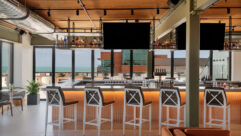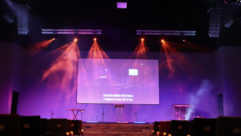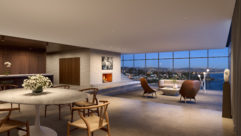 On this edition of the SVC Podcast, Contributing Editor Bennett Liles talks with Michael Evans of Alpha Sound & Lighting about how they completely outfitted the new sanctuary at the Destination Church in Saraland, Alabama. Michael discusses the sound system headed up by an Allen & Heath dLive 5000 mixer at front of house and he details the ME Personal Mixing System he set up for members of the praise band.
On this edition of the SVC Podcast, Contributing Editor Bennett Liles talks with Michael Evans of Alpha Sound & Lighting about how they completely outfitted the new sanctuary at the Destination Church in Saraland, Alabama. Michael discusses the sound system headed up by an Allen & Heath dLive 5000 mixer at front of house and he details the ME Personal Mixing System he set up for members of the praise band.
FOR MORE: GO TO PART 2
Links:
- Alpha Sound & Lighting
- Destination Church in Saraland, Alabama
- Allen & Heath dLive 5000 mixing system
- dLive DM64 MixRack
- Sennheiser ew 300-2 IEM G3
The Destination Church in Saraland, Alabama outgrew their original sanctuary and expanded to a new 1250 seat facility with all new sound, video and lighting. They called a trusted friend in Alpha Sound & Lighting to select the right components and do the entire installation. Michael Evans is with us today to give the rundown on how they did it with all the new gear. Coming right up on the SVC Podcast.
Mike, thank you for getting with us on the SVC Podcast from Alpha Sound and Lighting in Satsuma, Alabama. That’s down around Mobile isn’t it?
That is correct, sir. Thank you for having us today. We appreciate it very much. Yes, it is. We’re in North Mobile County right on the Gulf Coast.
OK and so the Destination Church that we’re going to be talking about is right there in your neighborhood. Not a long drive at all for you to get there and do the work.
About a five-mile drive from our office to this church and back, so we’re all in the same North Mobile County area there in Mobile, Alabama. [Timestamp: 1:05]
Alright so tell us first of all about Alpha Sound and Lighting. How long have you been around and what types of projects do you do? It sounds like you pretty much concentrate on churches.
That is correct. Alpha Sound and Lighting actually was started back in the early 70’s and the home office was in Valencia, California. I came on board in November of ’84 to run the Gulf Coast office out of Alabama. And basically all we do is houses of worship and schools. We don’t do much of anything else. We really kind of focus on those two areas and nothing else and I have personally been in the church audio world now for about 41-42 years. [Timestamp: 1:43]
That’s a mighty long resume so you guys know the ropes on schools and churches. Some big advantages to that and probably working a lot of repeat projects for the people in your area.
That is correct. And I’m blessed in the fact that I had the opportunity to be the front-of-house engineer at several large churches in the Mobile area as a part-time job so I spent a lot of time learning just what churches need all the way from contemporary to traditional. And basically it was a learning experience for me. Though I was getting paid to do a job, I was continually learning how could I retrofit and help these folks in the future – which here again was a blessing to me more than anybody else. [Timestamp: 2:21]
And tell us about Destination Church. What sort of a church is that as far as their worship style? Is it more traditional or is it modern with lots of live music?
It is a very aggressive contemporary-style worship. Anybody familiar with the South is also familiar with the Church of God and that what it is, it’s a Church of God. And they’re very, very aggressive with contemporary music, live bands, vocalists. Typically don’t do any choir of any nature. Their worship team is basically a full band with four to five vocals out front all the time. [Timestamp: 2:54]
So doing audio for that church you’re not just sitting back and listening to a choir and organ. You’re going to be busy all the time.
You’re going to be real busy, let me just tell you, okay? The gentleman that mixes for them, we spent quite a bit of time with him once we got the install done. We did several rehearsals with him. And the one positive thing that the church has going for them, Kyle Wilson, who is the worship leader, is 1) very aggressive from the standpoint of he’s tech-savvy, but he’s also a killer musician and he knows what he wants and he strives hard to get it. Our job was to help him get to that plateau. [Timestamp: 3:30]
You seem to know that church pretty well so how far back do you go with handling AV for them?
Well actually I started with them in 2016. They had moved out of their existing worship facility into a family life center they had to try to give them more room because they were growing rapidly. Another company did the install in that facility in ’15 and over a period of time, Kyle came to the church in 2016, and they couldn’t get that company to come back and do any work or service on the facility. And they, in turn, called us and asked us if we’d come over and take a look at it and I guess you could say the rest is history from there because we went in and started going through it. Limited budget trying to fix and make things work, which I guess we were relatively successful because they kept us around. [Timestamp: 4:18]
As you mentioned they’re a rapidly growing church and they outgrew their facility so what let to this new sanctuary and just starting a bigger place right from the ground up?
That’s a good question because at the point that they moved to the family life center they were actually doing four worship services a Sunday just to try to get everybody in. This place would only seat about 800 people max. I’m telling you, that was stuffing them in the door. And they’re running anywhere from 1,000 to 1,100-1,200 people a service now doing two services. They’re already at two services in the new facility. So the need was there, the budget was coming quick. The question was how do we plan and make this happen from not only the standing of the building point but also the AV world. So that all started in about 2017, if I’m not mistaken. That’s when I kind of got involved with them and started looking at this whole thing. [Timestamp: 5:13]
So they had your guys come in and do everything, sound, lighting, video, the whole works. We’re going to talk a bit about the sound part of the project. You decided on the Allen & Heath dLive S5000.
Yes, sir.
hy did you decide to go with that particular one?
Well, in order to answer that question I have to back up a year or two because 2016 going into ’17 Kyle was struggling with the system he had. He loves using wireless in-ear monitors for his band and everybody on stage. The problem was the console he had did not have enough outputs to supply what he needed. So that’s why I introduced to the church the Allen & Heath GLD80 console with an AR2414 and an AR84 which gave them quite a bit more inputs and outputs to facilitate what he was trying to do. My intention there was knowing that they were going to build this facility was to grow that to the new facility. Later, in 2017 going into ’18, I introduced them to the ME1’s and the MEU onstage personal monitor mixers to facilitate with their wireless ears. Well, that’s from the article is where all of a sudden everything started clicking with Kyle saying oh, if I stay with Allen & Heath everything just goes from one piece to another piece to another piece. The cool thing about Allen & Heath, and I love the product, it’s seamless as to what you can do and the expansion you can make into that device. So that all being said, that led us to the S5000 and more ME1’s and MEU’s in the new facility. [Timestamp: 6:44]
That looks like a perfect solution for this because since you’ve got a live band and a lot of people onstage it can handle that but it’s still not one of these big megaboards that you have volunteers trying to operate and maybe being a little intimidated by it.
That is correct. And the wonderful thing about this, like I said being in the church market for 40 years, the first word out of every church’s mouth is budget. Now you should know that as long as you’ve been in the industry, Bennett. And so I had to figure out okay, how can I retrofit what’s in the old facility over to the new facility. So the actual, the GLD80 we were using as the front-of-house in the old facility is now the broadcast mixer in the new facility and it’s tied to the S5000 via Dante. [Timestamp: 7:26]
Well, that should give you maximum flexibility in whatever they want to do. You’ve really covered some ground with them and especially being familiar with their needs. Where do you have the mixer? Is it where the lighting and everything is also controlled? Is it all from that same place?
Well, yes and no. The S5000 is in a front-of-house position about 50-60 feet off from the front-of-stage area, about center-house. That’s where your S5000, your front-of-house, your lighting console and your video switching is done. Off on stage left is a broadcast room that has where the GLD80 is and where all the camera switching is done. That was already in place in the old facility that we just moved over for them, and we as that’s where all my equipment racks are for my amplification processing and so forth. So it’s actually two locations that you work from. [Timestamp: 8:15]
It’s good having the broadcast facilities and the racks in probably a relatively secure location rather than out front where anybody in the crowd might get to them.
That’s correct.
Of course a big part of the house sound project was the speaker system so what main house speakers did you install for that?
What I did was ended up talking to Mike DeFreece at QSC Audio. We ended up using the WideLine 10’s with all QSC amplifiers and the Q-SYS processing is where we went. Just seamless. It’s just like Allen & Heath stuff; it’s all seamless. [Timestamp: 8:47]
It’s great that you were able to get close support from the company on their end of things. That could serve to cut a lot of corners for you.
Oh, yeah. And that’s the thing in our industry, Bennett. These manufacturers are willing to help you if you’re willing to ask. That’s the long and the short of it because Mike was kind enough to send one of his techs, Tripp Matthews, who is a WideLine 10 expert, he sent him out here to commission the system for us and just made my life that much sweeter. [Timestamp: 9:13]
So how did you get those speakers up there? Obviously since this is a new facility you didn’t have any previous wiring runs to re-use so you had to run everything from scratch right from the beginning?
Yes, sir. We had to run everything from scratch from the beginning. And of course the capability – here again, if you look at images of the facility it’s nothing but a big open metal building that looks like a theater. The ceiling is 60-foot tall, which obviously you’ve got to get up to that point or get the wire back to the location. Now the speakers are not that high; they’re down a bit from there. But yes, we had to run all-new cabling for everything as far as the WideLine 10’s, the lighting, the video. Everything had to be run new. [Timestamp: 9:51]
And so how did you set up the stage monitoring? I know that they were particularly interested in having an IEM system and I think that was Allen & Heath and Sennheiser.
Yes. That was the beauty of this whole thing. Again, they were already using the Sennheiser in-ear wireless monitor system over in the other facility. We brought that into the new facility and added some in-ear devices. And then what I did was I designed floor pockets on the stage area for both the ME1’s and the in-ear devices for that via a patch made back in my equipment room you can take any floor pocket and patch the ears to the mixer via that way. There’s not one live monitor on that stage anywhere. Everybody’s on ears including the vocalists. [Timestamp: 10:33]
That’s great because usually trying to mix and IEM with floor monitors can really get to be a tricky thing.
Yes, sir, it can. It keeps SPL down off that stage and it gives the front-of-house guy the freedom of actually doing a good, clean mix of the band and the vocals. [Timestamp: 10:51]
Sounds like all that worked out pretty well. In Part 2 we’ll get into the acoustics of the room and talk about the lighting because your guys did the whole thing on this. We’ve been talking with Michael Evans of Alpha Sound & Lighting in Satsuma, Alabama about the Destination Church in a whole new sanctuary completely outfitted by you’re company, Mike. We’ll see you again for more on this next week. Thanks for being with us.
Yes, sir. Thank you, Bennett.
The Destination Church has the right sound and the praise band now has control over their own monitoring. Michael will be back in Part 2 to give us the details on lighting, projection and video next week right here on the SVC Podcast.










